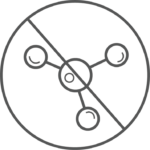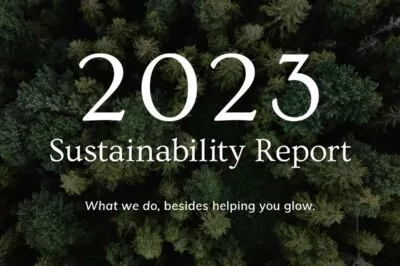Table of Contents[Hide][Show]
2018 Sustainability Report: Product+−
- 9,077,260: That’s about how many ml of harsh preservative-free goodness our customers purchased last year
- 168: That’s how many different toxic chemicals a day you’ve kept off your body using our products.
- 17: That’s how many third-party standards we’re upholding
- 0: That how many pounds of pesticides we’ve used this year.
- What’s next?
Since our inception, we’ve prided ourselves on providing our customers with unquestionably high quality, honest and effective products to support an organic and natural lifestyle.
We strive to live our values and practice sustainability throughout our business practices. This year, we thought we’d share with our audience the details of how exactly this looks.
What practices make Annmarie Skin Care different?
Organic and Wildcrafted Ingredients
We use organically grown ingredients in all our products, from farmers that use little to no pesticides and natural fertilizers to produce them. Growing organics and using them for our skin care is one of the most proactive ways for us to coexist with the environment, create a thriving ecosystem for all creatures, and make your skin look beautiful—all at the same time.
There are times when we don’t use certified organic ingredients, but in these cases, this is either because we have found a source that is grown organically but uncertified, or the ingredient has been wildcrafted.
Real, Pure Ingredients
If you can’t eat it, you shouldn’t be putting it on your skin. We don’t use any toxic chemicals, harsh preservatives, or synthetic fragrances. Our skin deserves pure ingredients from clean and pristine sources.
All of our products go through the most minimal amount of processing possible, if any, to ensure that the alive and active ingredients are not jeopardized. We don’t just show you a list of ingredients of herbs from nature — we make sure that these ingredients are in their most true and active form.
Transparency, Truth in Labeling
We, at Annmarie Skin Care, believe in full transparency when it comes to the ingredients we put in our products. We feel everyone deserves the right to know exactly what they are putting on their skin so they can make an informed decision of whether or not they want to purchase a product.
No GMO’s
Genetically engineered crops are slowly polluting our land here in the United States, as well as around the world. We feel it is essential to take part in the movement to protect the food supply for us and future generations by not using any GMO crops.
2018 Sustainability Report: Product
These statistics represent our efforts towards sustainability and ethical business practices when it comes to our products.

9,077,260: That’s about how many ml of harsh preservative-free goodness our customers purchased last year
We sold 9,077,260 ml of products last year. That means our customers have put 9,077,260 ml worth of preservative and toxic-free skin care on their bodies, replacing synthetic ingredients with natural, nurturing alternatives.

168: That’s how many different toxic chemicals a day you’ve kept off your body using our products.
According to the Environmental Working Group (EWG), the average US woman uses 12 personal care products and/or cosmetics a day, containing 168 different chemicals.
Furthermore, one of every five adults are potentially exposed every day to all of the top seven carcinogenic impurities common to personal care product ingredients — hydroquinone, ethylene dioxide, 1,4-dioxane, formaldehyde, nitrosamines, PAHs, and acrylamide. The top most common impurity ranked by number of people exposed is hydroquinone, which is a potential contaminant in products used daily by 94 percent of all women and 69 percent of all men. (EWG)
If you stick to only our products (plus clean oral care and hair care products), you’re keeping an average of 168 chemicals a day off your body. Our clean, natural products have helped reduce thousands of individuals’ exposure to these chemicals, many of which can cause hormone disruption, skin irritation, and a whole host of other issues.

17: That’s how many third-party standards we’re upholding
We are currently Made Safe and Leaping Bunny certified. Each of these certifications has a strict set of standards that companies must uphold to maintain their certification, and we uphold these with pride.
Made Safe screens ingredients against their Ingredient Database of known harmful chemicals, which is made up of thousands of chemicals found on scientifically authoritative lists from organizations and agencies around the world. They additionally examine ingredients for bioaccumulation, persistence, and general and aquatic toxicity.
The Made Safe seal literally means that a product is made with safe ingredients. There are 11 different categories of ingredients that Made Safe products are screened for. Check out those 11 ingredients here and read more about Made Safe here.
Leaping Bunny is the highest standard for cruelty free products and ingredients. The Leaping Bunny Logo is the only internationally recognized symbol guaranteeing consumers that no new animal tests were used in the development of any product displaying it.
The Leaping Bunny Standard consists of 6 criteria, known as The Corporate Standard of Compassion for Animals. Read more about their standard here.

0: That how many pounds of pesticides we’ve used this year.
That means our customers have avoided putting countless pounds of pesticides on their body by using our organic or wildcrafted skin care.
In 2012, the EPA reported that the US used 1,182 million pounds of pesticides in agriculture. This was the last time they put out a report of this nature, which you can view here. Because of a lack of information made available to consumers, it’s hard to tell exactly how many pounds of pesticides we’ve saved by only using organic and wildcrafted ingredients, but we can tell you it’s quite a bit.
Sustainability Report: Packaging
These statistics represent our efforts towards sustainability and ethical business practices when it comes to our packaging.

129,253: That’s how many plastic-free boxes we shipped in 2018.
Waste from shopping online is a growing problem, and one that we’re well aware of. That’s why we shipped 129,253 packages to happy customers last year free of any pesky plastic or wasteful styrofoam filler.
Research from the Ocean Conservancy shows that eight million metric tons of plastics enter our oceans each year, and in a few years, this could result in a pound of plastic for every three pounds of fish in the sea. E-commerce is no doubt a huge driver of this, and if more online based retailers were able to commit to cutting their plastic use in shipping, this could make a huge difference.

266,565: That’s how many petrochemical-free labels we adhered in 2018
The typical adhesive that secures a label to a bottle is commonly laden with petrochemicals. Using petrochemicals puts them into the environment and renders bottles unrecyclable. With our carbon footprint in mind, we’ve switched over to using a bio-based adhesive that is both recyclable and compostable.

156,770: That’s how many eco-friendly product inserts we printed this year
While we believe in cutting down waste as much as possible, we are required by law to include inserts that include our ingredients and how-to instructions with all of our products. Our inserts come from Eco-Friendly Printer, a Forest Stewardship Council (FSC) certified printing company.
Because they’re FSC certified, Eco-Friendly Printer only works with mills that are also FSC certified, which means that they use at least 30% post consumer waste for all of their paper. They also go a step further and work with companies that are Processed-Chlorine Free (PCF), which means that they offer paper that is bleached with oxygen or hydrogen peroxide instead of the typical chlorine bleach that can be detrimental to native fish and wildlife.

100%: That’s how much wind power our boxes are made out of
We package our products in boxes from Johnson Printing and Packaging, a Minnesota based company that runs on 100% wind power. The wind power comes from the Xcel Energy Windsource for Business Program which saves an estimated 500 tons of carbon emissions per year—that’s like planting 123 acres of trees every year.
Sustainability Report: Company Practices
These represent our internal efforts towards a more human-centered and sustainable workplace.

576: That’s how many paid volunteer hours our team received in 2018.
Giving back to our community is of the utmost importance to us, so each of our team members is allotted 24 hours of paid volunteer time a year.
We volunteered across several organizations, including Planned Parenthood, ACCESS Women’s Health Justice, Munchie Movement, Friends of Children of Brevard, Conscious Alliance, Art that Feeds, HeadCount, and local schools, to name only a few!

In-office sustainable practices
Our office is far from your typical work setting – instead of cold cubicles and fluorescent lights, we opt for cozy couches, beautiful woven rugs, and salt lamps. It’s not just a home-y vibe though, we operate this office like it is a home. A very eco-friendly home.
That means no single use dish ware, religious trash sorting, and a fridge stocked with local and organic goodies. We support local small businesses and farms—all our juice comes from our neighbors in San Francisco at Happy Moose Juice, and we get local, seasonal produce from Good Eggs.
What’s next?
We are constantly evolving with the planet in mind and striving to increase our sustainable business practices. We’re aiming for 2019 to be our most sustainable year yet. Stay tuned for announcements on how we’re becoming even more eco-friendly this year!
How would you like to see us become even greener in 2019? Share in the comments below or email suggestions at newyou@annmariegianni.com.




Kudos to the lovely ASC Team for being courageously transparent & sincerely open to suggestions! I am proud & happy to be your Insider.
Thank so much for the report and keep up the good work. I plan to share it with some friends and hope they’ll take good care of themselves and use your products.
Bravo!